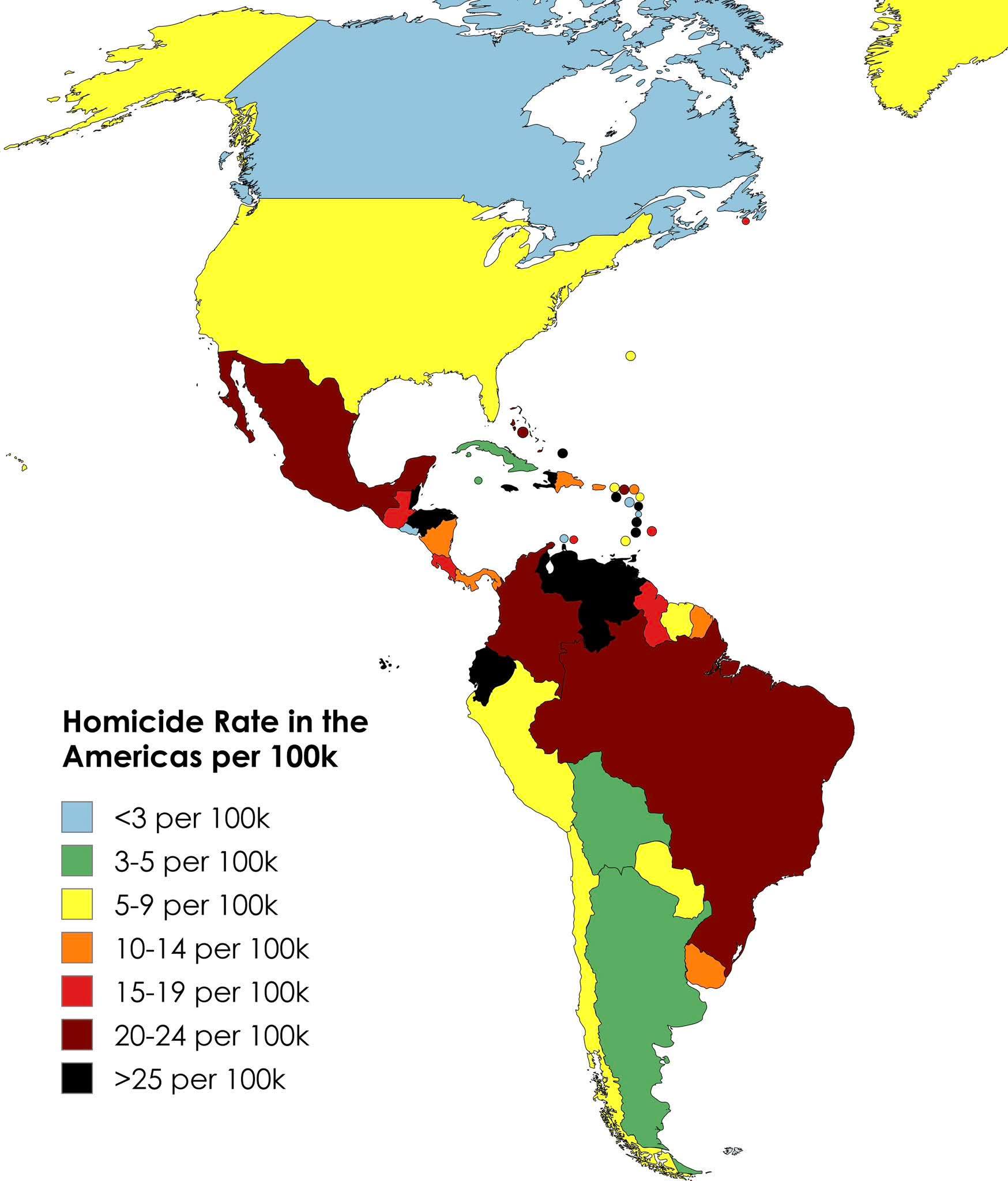Homicide Rates in the Americas Map


Marcus Rodriguez
Historical Geography Expert
Marcus Rodriguez specializes in historical cartography and geographic data analysis. With a background in both history and geography, he brings unique...
Geographic Analysis
What This Map Shows
The "Homicide Rates in the Americas Map" visually represents the varying homicide rates across different countries within the Americas. It provides a stark illustration of how violence manifests differently across regions, highlighting not just the numbers but also the underlying social and political factors that contribute to these rates. The map uses color gradients to indicate the intensity of homicides per 100,000 inhabitants, offering a clear and immediate understanding of where violence is most prevalent.
Deep Dive into Homicide Rates in the Americas
Homicide rates serve as a crucial indicator of societal health and stability. Interestingly, the Americas exhibit some of the highest homicide rates in the world, especially in Central America and certain parts of South America. Factors influencing these rates are complex and multifaceted, often rooted in economic conditions, drug trafficking, gang violence, and political instability.
For instance, countries like El Salvador, Honduras, and Venezuela consistently rank among the highest in the world for homicide rates. In El Salvador, the rate has been reported as high as 52 homicides per 100,000 people in recent years. This violence is often linked to powerful gangs, such as MS-13 and Barrio 18, which not only engage in drug trafficking but also exert control over local communities through intimidation and violence.
In contrast, countries like Canada and Chile have significantly lower homicide rates, often attributed to stronger law enforcement, social services, and economic stability. Canada, for example, has maintained a homicide rate around 1.8 per 100,000 people. The differences in homicide rates across these nations underscore the varying degrees of governmental effectiveness and social cohesion.
Interestingly, urban areas typically experience higher homicide rates than rural regions, driven by factors such as poverty, unemployment, and access to weapons. Major cities like São Paulo and Mexico City see spikes in violence, often linked to organized crime and territorial disputes. However, initiatives focusing on community policing and outreach programs in some urban centers have shown promise in reducing violence and fostering safer environments.
Regional Analysis
In North America, the United States has a homicide rate that fluctuates around 5 per 100,000 people, with significant variations between states and cities. Urban centers such as St. Louis and Baltimore report rates much higher than the national average, often due to socioeconomic disparities and systemic issues related to crime and justice. The U.S. also faces challenges with gun violence, which significantly contributes to its homicide statistics.
Moving to Central America, countries like Honduras and El Salvador present a stark contrast. These nations grapple with pervasive gang violence, which is a primary driver of their extraordinarily high homicide rates. As mentioned, El Salvador's rate of 52 per 100,000 people is alarming and reflects years of social turmoil and inadequate governmental response to crime.
South America displays a mixed picture. While Brazil has regions with alarming homicide rates, particularly in the favelas of Rio de Janeiro, other areas report significantly lower rates. Chile, often praised for its stability, has managed to keep its homicide rates relatively low at around 3 per 100,000 people, largely due to effective governance and socioeconomic policies.
In the Caribbean, countries like Jamaica have faced challenges with violent crime, leading to elevated homicide rates. However, initiatives to strengthen law enforcement and community engagement are showing signs of improvement.
Significance and Impact
Understanding homicide rates in the Americas is not just an academic exercise; it’s vital for shaping policies that can mitigate violence and improve public safety. High homicide rates often correlate with broader issues such as poverty, corruption, and lack of access to education. By addressing these root causes, governments and organizations can work towards creating safer communities.
Moreover, the implications of violence extend beyond immediate safety concerns; they affect economic stability, deter investment, and disrupt community cohesion. Interestingly, countries with lower homicide rates often enjoy greater economic prosperity and social trust, demonstrating the interconnectedness of these issues.
As we look to the future, trends in homicide rates could shift in response to various factors, including changes in drug trafficking routes, economic recovery post-pandemic, and advancements in community policing strategies. Understanding these dynamics will be crucial for policymakers and stakeholders in crafting effective responses to violence in the Americas. Have you noticed how discussions around violence often overlook the underlying socioeconomic factors? Addressing these can pave the way for real change and safer communities across the continent.
Visualization Details
- Published
- September 29, 2025
- Views
- 48
Comments
Loading comments...